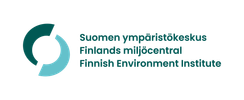The risk of extensive blue-green algae blooms remains significant in open sea areas
A high risk of blue-green algae blooms in open sea areas persists in the Gulf of Finland, the Archipelago Sea and also in southern and central parts of the Bothnian Sea.
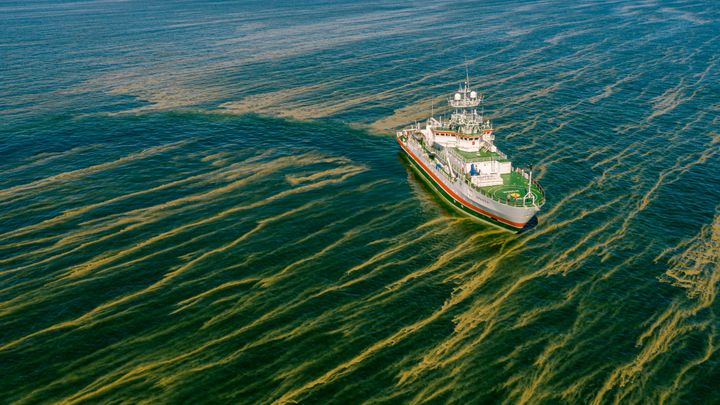
Extensive blue-green algae blooms are likely to occur in the open sea areas close to Finland during the summer as the nutrient situation in the Baltic Sea remains largely unchanged. The risk of the formation of rafts of blue-green algae is considerable in the northern part of the main basin of the Baltic Sea as well as in the Gulf of Finland, the Archipelago Sea and a large part of the Bothnian Sea. The risk remains low in the Bothnian Bay.
The extent of algae rafts and the duration of the blue-green algae bloom are affected by the temperature and wind conditions of the summer. If the nutrient situation in the main basin of the Baltic Sea improved, this would significantly reduce mass occurrences of blue-green algae, as the status of the main basin is reflected in the situation of open sea areas in the north. Local variations in the blue-green algae situation may be great on the coast and in the archipelago and also take place faster than in the open sea. Local blue-green algae blooms have also occurred annually on the Bothnian Bay coast.
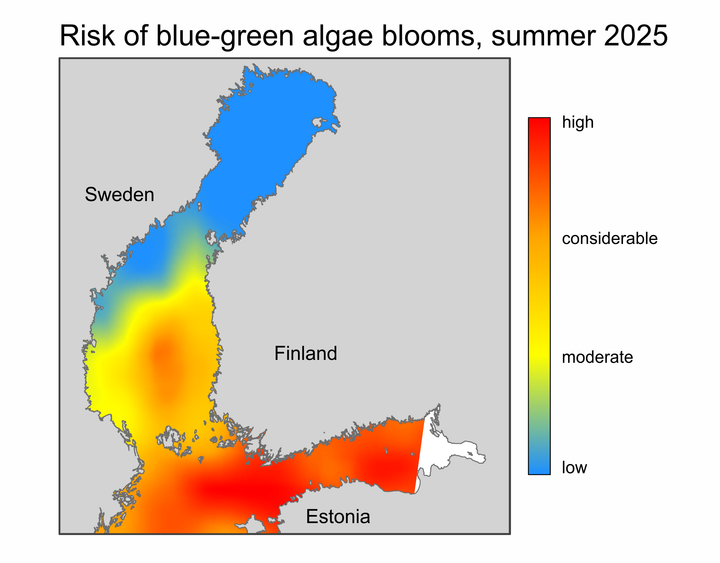
Nutrient situation still creates favourable conditions for mass occurrence of blue-green algae
The nutrient situation in the Baltic Sea continues to create favourable conditions for blue-green algae blooms in open sea areas close to Finland, with the exception of the Bothnian Bay. Last winter, the prevailing strong westerly winds promoted the mixing of water layers in the main basin of the Baltic Sea and in the Gulf of Finland. While the oxygen situation in the Gulf of Finland improved considerably, the mixing unfortunately brought plenty of phosphorus up to the surface layers. The phosphorus content in the Bothnian Sea has increased in the 2000s, and the risk of blue-green algae blooms appears to persist in this area.
This year, too, the spring bloom of phytoplankton used up almost all available nitrogen in the surface layer, whereas plenty of phosphorus remained in the surface water. These conditions further provide good preconditions for blue-green algae blooms, as in sea areas the species that form extensive algae blooms are able to use nitrogen gas dissolved from air into water. This gives these blue-green algae species a competitive advantage over others.
Large blue-green algae blooms usually begin to occur in the open sea area after Midsummer. Rafts of blue-green algae form in the open sea following a period of warm and sunny weather of a couple of weeks, especially if it includes a few days of slack winds. In summer, strong northerly winds may cause an upwelling of phosphorus-rich bottom water into the surface layer, which may contribute to blue-green algae growth.
Monitoring the state of the sea also produces information for forecasting blue-green algae risk
To assess the risk of occurrence of blue-green algae, monitoring data collected by the Finnish Environment Institute and the Swedish Meteorological and Hydrological Institute (SMHI) concerning the open seas as well as the ELY Centres' coastal monitoring data were used. In addition, data produced by Alg@line monitoring performed on merchant ships, satellite images and weather data of the EU’s Copernicus service were utilised. The forecast for blue-green algae raft formation was compiled using these datasets, combining forecasting methods based on statistical mathematics and machine learning.
Blue-green algae reports start in Midsummer week
This summer, the Finnish Environment Institute will report weekly on the general blue-green algae situation between 19 June and 7 August 2025. The report will be published on Thursdays at 13:00. However, the monitoring of the blue-green algae situation will continue from the beginning of June until the end of September. For blue-green algae observations, see the national map on Järvi-Meriwiki.
Blue-green algae can produce various toxins, including skin or eye irritants. Significant blue-green algae blooms should always be treated with caution. The blue-green algae situation in public bathing waters is monitored by municipalities and cities.
Keywords
Contacts
Risk evaluation of blue-green algae blooms in Finnish marine areas:
Senior Research Scientist Jouni Lehtoranta, Finnish Environment Institute Syke, firstname.lastname@syke.fi, tel. +358 295 251 363
Blue-green algae ecology in the Baltic Sea:
Senior Research Scientist Sirpa Lehtinen, Finnish Environment Institute Syke, firstname.lastname@syke.fi, tel. +358 295 251 353
Modelling:
Senior Research Scientist Heikki Peltonen, Finnish Environment Institute Syke, firstname.lastname@syke.fi, tel. +358 295 251 304
Communications Specialist Eija Järvinen, Finnish Environment Institute Syke, firstname.lastname@syke.fi, +358 295 251 242
Media service at Finnish Environment Institute
Our Media Service provides information on research, helps journalists find experts for interviews and provides photos for media use.
Our Communication experts will answer your inquiries on weekdays from 9 am to 4 pm.
Images
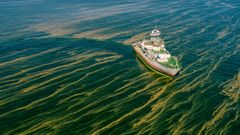
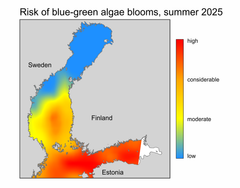
Links
Finnish Environment Institute - We build hope through research.
Finnish Environment Institute
Latokartanonkaari 11
00790 Helsinki
+358 295 251 000
It is time to move beyond solving environmental problems one by one, to systemic sustainability transformations. The Finnish Environment Institute (Syke) contributes to building a sustainable society through research, information and services. The Finnish Environment Institute is a research institute with 700 experts and researchers located in Helsinki, Oulu, Jyväskylä and Joensuu.

Subscribe to releases from Suomen ympäristökeskus
Subscribe to all the latest releases from Suomen ympäristökeskus by registering your e-mail address below. You can unsubscribe at any time.
Latest releases from Suomen ympäristökeskus
Viikkokatsaus 8.–12.12.20254.12.2025 12:30:18 EET | Tiedote
Hei! Tässä tiedoksesi meillä Suomen ympäristökeskuksessa ensi viikolla ilmestyviä tiedotteita, uutisia, kampanjoita, blogeja ja uutiskirjeitä. Mukana myös tulevia tapahtumia ja webinaareja. Jakelemme viikkokatsauksen torstaisin STT:n kautta. Koosteet löytyvät myös STT-uutishuoneesta, josta voit tilata kaikki Suomen ympäristökeskuksen tiedotteet.
Fisk och kilowattimmar kan förenas i Kymmene älv3.12.2025 08:53:17 EET | Pressmeddelande
Vandringsfiskens livsmiljöer kan förbättras genom smarta flödesläsningar utan betydande förluster för energiproduktionen.
Kymijoella mahdollista yhdistää kalat ja kilowattitunnit3.12.2025 08:51:25 EET | Tiedote
Vaelluskalojen lisääntymismahdollisuuksia voidaan parantaa virtaamajärjestelyillä ilman merkittäviä menetyksiä energiantuotannolle.
Viikkokatsaus 1.–5.12.202527.11.2025 12:04:01 EET | Tiedote
Hei! Tässä tiedoksesi meillä Suomen ympäristökeskuksessa ensi viikolla ilmestyviä tiedotteita, uutisia, kampanjoita, blogeja ja uutiskirjeitä. Mukana myös tulevia tapahtumia ja webinaareja. Jakelemme viikkokatsauksen torstaisin STT:n kautta. Koosteet löytyvät myös STT-uutishuoneesta, josta voit tilata kaikki Suomen ympäristökeskuksen tiedotteet.
Finland must accelerate efforts towards a circular economy of plastics27.11.2025 07:02:00 EET | Press release
Progress has been made in advancing the circular economy for plastics, but Finland remains far from its targets and significant additional measures are needed. A new report from the PlastLIFE project, published by the Finnish Environment Institute, highlights how reducing unnecessary plastic consumption, preventing littering, and improving recycling efficiency are key to achieving a circular economy. The issue is pressing, as plastics continue to have considerable climate and environmental impacts. Finland’s goal is to establish a sustainable circular economy for plastics by 2030.
In our pressroom you can read all our latest releases, find our press contacts, images, documents and other relevant information about us.
Visit our pressroom